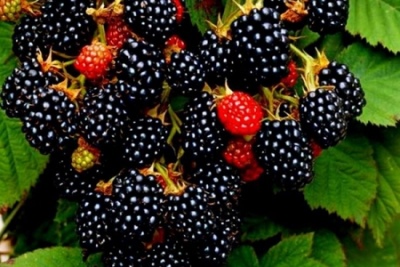
- Authors: USA, Cornell University at the New York State Experimental Station
- Repairability: No
- Berry color: black with a bluish bloom
- Taste: sweet
- Ripening period: average
- Berry weight, g: up to 5
- Yield: up to 1.1 kg per bush
- Frost resistance: winter hardy. -30–34 ° C
- Drop off location: no wind or drafts
- Fruiting period: at the end of June
Black Jewel is a black raspberry variety developed in the United States by Cornell University at the New York State Experimental Station. The cultivar was a cross between NY 29773 and Dundee raspberries. In Russia, Black Jewel is becoming more and more popular every year.
Description of the variety
The plant has the following features:
erect bush, vigorous, height 100 cm;
shoots are erect, flexible, elastic, green in color, darken with age, have many thorns;
leaves are large, dark green, covered with pile on the underside, serrated along the edges.
Ripening terms
It is a non-repairable variety with a medium ripening period. The fruiting period occurs at the end of July.
Yield
The variety is distinguished by a high degree of productivity, from 1 bush you can collect up to 1.1 kg of berries.
Berries and their taste
The fruits are black in color with a bluish tint. The shape is round, weight - up to 5 g. The berries taste sweet, the pulp is juicy, with a blackberry flavor. And also the fruits are characterized by good transportability, which allows them to be used for commercial purposes.

Growing features
The variety is distinguished by drought resistance and winter hardiness, it is able to endure frosts down to -34 degrees. Of the advantages, resistance to adverse weather conditions is noted. And also keep in mind that this is a self-pollinated variety that does not need to be planted next to red-fruited varieties in order to prevent crossbreeding.
Site selection and soil preparation
When landing, use the following guidelines:
choose an area for planting that is well lit by the sun and is not located in a draft;
any soil is suitable, but it is important that it is not waterlogged;
the optimal time for planting a seedling with an open root system is spring or autumn, the cutting in a container can be planted at any time from spring to autumn.
The planting process itself consists of several stages.
2-4 weeks before planting, dig holes 40-45 cm deep.
Fill them one third with organic or mineral compounds, for example, humus, compost, chicken droppings, wood ash.
Arrange drainage. Use, for example, a layer of rubble or gravel.
Mix soil and fertilizer, place the mixture in the hole.
Plant an escape.
Water the planting area liberally and add a layer of mulch.



Watering and feeding
Most of all, the culture of the presented variety needs watering in the first year of the growing season. And it is also required to moisten the soil abundantly in the summer, especially when the filling begins to form on the berries. The volume of water at a time is 30-40 liters, the frequency on average is 1-2 times a week, in the fall you need to ensure minimum watering.
The variety has good yields and vigorous growth, so the crop needs fertilization. Top dressing is applied during the following growing seasons:
in early spring, after the snow has melted;
at the stage of ovary formation;
at the end of the harvest.
Organic and mineral fertilizers are used as additional nutrition. It is important to avoid nitrogen formulations when applying top dressing in the fall.



Diseases and pests
The presented variety has high immunity to insects and anthracnose, but can be affected by verticillium. To avoid this ailment, it is recommended to reduce the amount of nitrogen fertilizers, and also not to plant a plant in the garden where potatoes, tomatoes, peppers, and blackberries have been growing for the last five years. In addition, roses and chrysanthemums planted nearby can attract the disease.
For prophylaxis in industrial farms, fungicides are used; for a private plot, the means "Trichodermin" and "Fitosporin" are suitable.

Unfortunately, raspberries, like other plants, do not bypass various diseases and pests. Only armed with the knowledge and the necessary means for this, you can cope with such troubles. To help the plant, it is very important to be able to recognize the disease in time and begin timely treatment.
Reproduction
Bushes can be planted by dividing or by dropping the tops. The first method is simple for novice summer residents, so we will dwell on the second method in more detail.
Tilt the lower branches to the garden bed, cut off 3-5 cm of the shoot, remove a few leaves and sprinkle this part with soil. Provide abundant watering during the summer, and after a year, separate this area from the mother sprout. Dig the rooted shoot with an earthen clod and transplant to another place.








































































